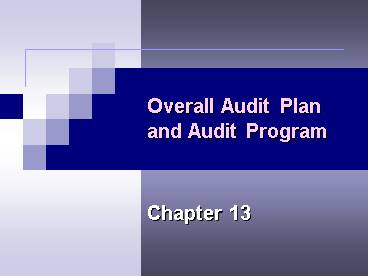Overall Audit Plan and Audit Program - PowerPoint PPT Presentation
1 / 26
Title:
Overall Audit Plan and Audit Program
Description:
Overall Audit Plan and Audit Program Chapter 13 Midterm topic guide will be ready and posted to the website by sometime Saturday (2/25) Types of Audit Tests Types of ... – PowerPoint PPT presentation
Number of Views:3715
Avg rating:3.0/5.0
Title: Overall Audit Plan and Audit Program
1
Overall Audit Planand Audit Program
- Chapter 13
2
- Midterm topic guide will be ready and posted to
the website by sometime Saturday (2/25)
3
Types of Audit Tests
Procedures to obtain an understanding of internal
control (Ch 10) Focused on understanding the
design and operation of aspects of I/C
necessary to plan the rest of the audit
Tests of control (Ch 10) Procedures used to
obtain evidence needed to assess control risk.
4
Types of Audit Tests
Substantive tests of transactions Procedures
designed to test for dollar misstatements of
financial statement balances.
- Analytical procedures (Ch 8)
- To indicate possible misstatements
- To reduce tests of details of balances
Tests of details of balances Focus on ending G/L
balances
5
Types of Audit Tests and the Audit Risk Model
6
Types of Audit Tests andthe Audit Risk Model
7
Relationship Between Types of Tests and Evidence
(Table 13-2)
Reperformance
Analytical
Inquiries of the client
?
?
?
?
?
?
?
?
?
?
8
Audit Assurance at Different Levels of Internal
Control Effectiveness (Figure 13-3)
9
Impact of Information Technology onAudit Testing
SAS 80 (AU 326) and SAS 94 (AU 319) provide
guidance for auditors of entities that transmit,
process, maintain, or access significant
information electronically.
10
Impact of Information Technology on Audit Testing
Computer assisted audit techniques (CAATS) may be
used to test automated controls or data.
Reports produced by IT may be used to test the
effectiveness of IT general controls.
11
Variations in Evidence Mix
12
- Chapter 13 starts putting the pieces of the
audit together.
13
Audit Program
It is convenient to think of the audit program as
consisting of the three major classes of tests
Tests of controls and substantive tests of
transactions
Analytical procedures
Tests of details and balances
14
Role of Audit Tests Sales Collection Cycle
Example (Fig 13-2)
15
Designing Controls and Substantive Tests of
Transactions (Figure 13-4)
Perform procedures to understand internal control.
Audit procedures
Sample size
Items to select
Timing
16
Approach to Designing Tests of Details of
Balances (Figure 13-6)
17
Partial View of Table 13-4Tests of Details of
Balances Audit Program
18
Phases of the Audit Process
- Plan and design an audit approach.
2. Perform tests of controls and substantive
tests of transactions.
3. Perform analytical procedures and tests of
details of balances.
4. Complete the audit and issue an audit report.
19
Audit Objectives (Ch. 6)
20
Types of Evidence (Ch. 7)
1. Physical examination 2. Confirmation 3.
Documentation 4. Analytical procedures 5.
Observation 6. Inquiry of the client 7.
Reperformance
21
Summary of the Audit Process
22
Summary of the Audit ProcessPhase I
Accept client and perform initial planning.
23
Summary of the Audit ProcessPhase I
Set materiality and assess acceptable audit risk
and inherent risk.
24
Summary of the Audit ProcessPhase II
25
Summary of the Audit ProcessPhase III
Perform analytical procedures.
Perform tests of key items.
Perform additional tests of details of balances.
26
Summary of the Audit ProcessPhase IV































